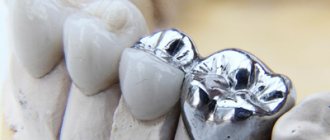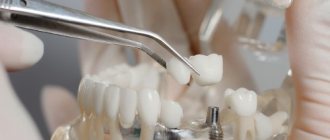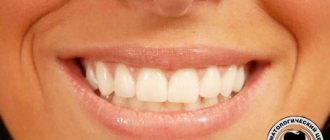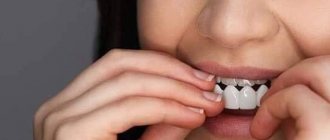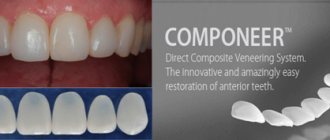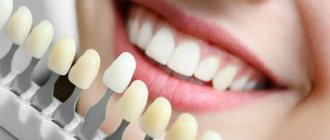Types of ceramic veneers
The classification of veneers is related to their manufacturing technologies.
Pressed veneers are made from dental porcelain. As a result, an ultra-thin plate is created, which is subsequently ground and glazed, which creates a pleasant natural shine. A similar technique is used to create ultra-thin E-max ceramic veneers.
Zirconium veneers are a separate type of ceramic veneers that are made from zirconium dioxide. The basis of the two-layer structure is a zirconium plate. A ceramic layer is applied to it. The zirconium frame provides extra strength.
Other benefits include:
• the shade does not change over time; • thickness of only 0.3 mm ensures invisibility; • does not cause allergies; • service life 20 years.
Not everyone can afford the price. This is the drawback.
A popular service at our clinic is the installation of feldspathic veneers. During their manufacture, the technician applies ceramics layer by layer, which is a precise, highly artistic work. The ceramic layers are no more than a fraction of a millimeter. During the specialist’s work, anthropometric data are taken into account. With their help, it is possible to present the overall picture of the dentition, the smile line, and plan the ideal shape of the structure. As a result, feldspathic veneers cannot be distinguished from natural teeth. .
Lumineers
The perfect (Hollywood) smile can be achieved with lumineers. The design of lumineers is slightly thinner than conventional veneers. The shape is similar to petals. To fix lumineers, veneer adhesive is used.
There are standard and individual lumineers. The former have a variety of colors and sizes. They are somewhat similar in installation to false nails. The latter are made in the laboratory depending on the individual characteristics of the patient.
Lumineers increase the volume of teeth. They are used in cases:
- Slight discoloration of teeth. The design of the devices is very thin (0.3 mm), translucent, so they cannot hide the obvious unevenness of color.
- Small diastemas between teeth. Lumineers cover them well.
- The presence of chips on the teeth and their concealment. Here, individual lumineers will be used, in which the thickness at the chip site should be greater.
- The appearance of cracks in the enamel that you want to hide.
Lumineers have a significant drawback, which manifests itself in a short service life due to low reliability. Broken material unfortunately cannot be repaired. Some procedures will need to be completed first.
A positive aspect of veneering is that the glue on which it is attached contains the element fluorine. Therefore, experts say that wearing such structures is beneficial for tooth enamel.
After installing the veneers, the dentist will invite the patient for a second appointment. This will happen in about a week. The doctor will examine your teeth and gums. He will look at how the teeth have adapted to the installed material. In addition, the doctor can perform the final steps to adjust the veneers. That is, after his manipulations, the mouth will look even better. Now it will be easier for the tooth and veneer to cope with their functions.
Manufacturing and installation
Ceramic veneers are installed after successive stages of work by a doctor at the ROCOSCLINIC clinic.
1. Consultation - a specialist finds out what aesthetic problems concern the client. The bite, defects, and enamel shade are taken into account. 2. The technician performs virtual modeling of teeth using a computer program. With the help of simple manipulations, thanks to mock-up technology, the formed volume of teeth helps to create temporary plastic structures. 3. Fitting, approval of the shape and color of the crown of the teeth. 4. Fixation of permanent ceramic restorations using a microscope ensures high precision.
Products are manufactured in our dental laboratory.
Types of temporary microprostheses, including preparation and creation of impressions
What types of removable veneers are there?
- temporary plates - such plastic overlays are installed by the doctor in the dental office, after preparing and preparing the teeth for the installation of permanent structures. They will need to be worn until permanent ceramic or, for example, zirconium plates are ready. By the way, many people are interested in the question of how old people are to get veneers. So, a similar procedure is performed on patients at least 18 years of age,
- removable template mouthguards and overlays - you can buy them on the Internet, pharmacy or cosmetics store. However, they are really of little use - neither cosmetic mouth guards nor overlays with a cheap adhesive composition will stick to the teeth for a long time and reliably. Moreover, they can damage the enamel and mucous membranes, provoke inflammation,
- individual removable Snap-On Smile - such cosmetic prostheses are made from impressions exclusively in the laboratories of the American company DenMat in the USA or Europe. That is, in a Russian clinic you can undergo all the preparatory procedures, but you will have to wait about a month for the arrival of the finished plates. Such designs, by the way, also allow you to disguise missing teeth. However, experts do not recommend wearing them on a permanent basis - this is an acceptable option as a temporary measure.
How is a ceramic veneer different from a lumineer?
Ceramic veneers and lumineers are not the same thing. Lumineers are also dental coverings, only:
• veneers are thicker, so you have to grind off the enamel layer before installing them. In addition, at the junction of the gum and the attachment of the plate, after a while a small space may form where food debris will accumulate; • the warranty period for veneers is shorter; • veneers are cheaper than lumineers.
Lumineers have recently appeared. People often call them “Hollywood”, as they help create the snow-white smile of celebrities.
Veneers – what are they?
There are two types of veneers:
- Therapeutic. Veneers are made directly on the patient’s tooth. Their composition includes composite materials that are very similar to filling materials. Often such dental devices are used for chipping (in this case, the chipping area can occupy 60%). That is, the procedure can be considered as restoration or extension of a tooth. If we do not consider the case of chipping, then under other circumstances the teeth are ground down a little, a veneer is formed, then they are ground and polished.
- Orthopedic veneers, lumineers. These materials are manufactured in a laboratory environment. In this case, an impression of the patient’s teeth must be taken. They are glued to the tooth using glue specialized for these conditions.
Therapeutic veneers are affordable for many. The price of their installation ranges from 2,500 to 15,000 rubles. The cost threshold depends on the prestige of the clinic, the characteristics of the treatment and the materials used.
Orthopedic ones are much more expensive in price than therapeutic ones. The price starts from 15,000 and goes up to 50,000 rubles. The same factors influence the price here.
Caring for ceramic veneers
After ceramic veneers have been installed, you should not forget about the features of oral care.
1. It is necessary to avoid severe mechanical stress and consumption of solid food. All this can lead to damage to the product; 2. You cannot eat cold and hot foods at the same time. Alternating contrasting temperature conditions can cause the ceramic veneer to crack. 3. There is no need to use pastes containing abrasive substances, otherwise the ceramics are subject to microcracks. It is in them that coloring substances accumulate, which over time spoil the appearance of the veneers. 4. You should pay attention to your toothbrush. Her bristles should be soft. To treat the surface of teeth not covered with veneers, you can use a brush with medium hardness. Vibrating brushes can promote peeling of records, so the choice should be in favor of simple ones. 5. It is necessary to include the use of an irrigator into a healthy habit. A stream of water removes food between the teeth where the brush did not reach; micromassage exerts pressure on the gums. All this has a beneficial effect on gum health.
It makes sense to regularly visit the dentist of the ROCOSCLINIC clinic in order to promptly eliminate problems and carry out professional hygiene.
Despite the strength of the structure, it is necessary to adhere to these recommendations. Ceramic veneers will last longer and look better if you take proper care of your mouth.
Situation: veneer failed
In practice, there were cases when the veneer fell off. How to fix? You need to assess the situation and carefully study the problem, and the doctor will suggest a solution.
If the material has simply peeled off, then you need to remove it with careful movements (so as not to damage it).
If you see in your mouth that one part has peeled off, then there is a possibility that the device remains intact. If the veneer falls off as a whole, then the doctor will definitely be able to fix it in place.
In case of obvious breakdown of the material, the dentist will have no other solution but to replace it with a new one.
How can you tell if the entire veneer has fallen off? You need to look at the condition of the fallen element. If it has a symmetrical and rounded shape, then the veneer is intact. If you look closely at the tooth and see a residue on it, then the veneer is 100% broken.
In order to help the dentist with further treatment, you must show him the fragments. It is recommended to save all parts of the broken material. To do this, you need to fill a small box with cotton wool and put the debris there.
Next, you need to report the incident to the doctor. The doctor will solve the problem. But in general, the potential risk of such a problem is small. The tooth will remain without protection for some time (two weeks). There will be no significant changes in him for weeks.
Veneer detachment can be detected independently. It happens that you feel a rough surface (as opposed to a smooth veneer) in your mouth. The tip of the tongue undergoes irritation. And yet, a ground tooth will definitely react to temperature changes, since the surface has no protection.
And in the future, carefully analyze the situation and determine what actions you took could cause the breakdown. Once you find the answer, never repeat such actions again. If you cannot determine, consult your dentist.
Where is the ROCOSCLINIC clinic located?
Moscow is a city where you can get any dental service, one of which includes the installation of ceramic veneers. Call us, sign up for a consultation and we will be happy to consider your problem related to the aesthetic unattractiveness of your teeth.
The task of doctors is not only to treat, but also to restore the beauty of a smile. And it works out well. See for yourself. We know how to make your smile radiant and charming.
We are waiting for you at the address: Moscow, 17-Maryina Roshchi pr-d, no. 1.
Is it possible to install veneers without damaging the enamel?
If we talk exclusively about removable aesthetic mouthguards, then standard polymers, silicone, polypropylene and other types of plastics of appropriate shades are usually used for their manufacture. All these are inexpensive materials that can be easily processed and painted. Such structures are installed in the oral cavity without any grinding of teeth or taking impressions. However, due to their standardized size, such structures practically do not stay in the oral cavity; it is impossible to speak normally with them, chew food, or even smile.
On a note ! There is a separate type of cosmetic removable dentures Snap-On Smile. They are made individually for each patient, so they require preliminary impressions. The development belongs to the American company DenMat, so the prostheses themselves are created in the laboratory of the manufacturing company. Such onlays stay in the mouth much better and allow you not only to transform the aesthetics of your smile, but also to visually restore missing teeth. However, this option can only be considered as a temporary solution. Read more about Snap-On Smile dentures in our separate article.
However, temporary onlays can also look like real classic ones, that is, one thin plate for each tooth. In dentistry, such products are usually made of plastic and fixed with temporary adhesive until full-fledged microprostheses made of ceramic or, say, zirconium are ready. In this case, preparation and making impressions are an integral stage of smile restoration.
What if you choose subtle options?
Sometimes, when choosing ultra-thin plates, for example, “Lumineers” from the same DenMat company, it is possible to completely avoid turning the living enamel, but here we are talking about full-fledged permanent veneering. On sale you can find cheap template analogues - plastic overlays in a set with glue of dubious quality. Such products cannot be of high quality and, as noted above, it is better to avoid them so as not to harm the enamel and gums
“Veneers dull the sense of taste”
The taste of food may change if the patient has composite veneers installed after incomplete polymerization. In this case, impurities are formed in the residual monomer of the dental veneers - hence the unpleasant sensations in the mouth and the changing taste of products.
How to avoid this? Install high-quality ceramic veneers.
What glue is used to install removable veneers and its features
So-called removable veneers, which look like mouth guards, are simply placed on the teeth. To secure them, no adhesive compounds are needed. Although we cannot talk about any reliable fixation in the case of template cosmetic prostheses. No complicated instructions for their use are required either.
The removable plates, which follow the shape of the teeth and are sold in packs of 70 pieces, have a template shape. They are attached using a special glue that comes in each set. The kit usually also includes a special brush and tweezers. But if professional dentistry uses proven compounds, then in this case it is not entirely clear what exactly the composition of the glue is and how safe it is for the body. Therefore, dental experts strongly recommend not to risk your health.
Classic non-removable products are fixed with a special heavy-duty adhesive; subsequently, you will not be able to remove them yourself. But for Cerinate (DenMat) lumineers they use a special patented adhesive composition, which additionally has protective properties for the enamel[1].
Veneers are thin overlays that are installed on the front surface of the teeth of the upper and lower jaw.
Indications for installation of veneers:
- Tremas and diastemas (distance between teeth)
- the presence of cracks, chips, abrasions on the teeth
- anatomically incorrect position of a tooth or teeth in the dentition
- abnormalities in the structure of teeth
Contraindications for installing veneers:
- Bruxism (involuntary clenching of teeth that occurs during sleep due to spasm of the masticatory muscles)
- malocclusion
- carious lesions and poor oral hygiene
- absence of a large number of chewing teeth
- playing sports that involve a high risk of jaw injury (activities using transparent mouth guards).
- gingivitis in the acute stage, periodontitis
- dead and severely decayed teeth
Types of veneers:
- direct veneers (composite restorations)
- indirect veneers (orthopedic)
Composite veneers are made directly in the patient's mouth using filling material. A layer of enamel is prepared, then phosphoric acid is applied to the tooth tissue, washed off, dried, then a bond is applied, with the help of which the filling adheres firmly to the tooth tissue. Then a nanohybrid composite is applied layer by layer, which hardens under the influence of an ultraviolet lamp.
Advantages and disadvantages:
- Composite veneers are inferior in aesthetic qualities to orthopedic veneers.
- filling material absorbs food coloring and darkens over time
- fragility (less reliable and susceptible to chipping)
- over time, the surface of the composite becomes less smooth and requires regular polishing by the dentist,
- service life on average 3-5 years
- The cost of composite veneers is lower than ceramic
There are the following types of orthopedic veneers:
- Ceramic (farmor veneers) Emax (maximally similar to your teeth)
- Zirconium veneers (this type of veneers is highly durable, but is inferior in aesthetic properties to ceramic veneers)
- Lumineers are the same as veneers, only their thickness is 0.2 mm, so the teeth do not require preparation, the adhesion to the enamel is stronger. Lumineers are not made for severely crooked teeth, or for teeth with abrasion
Veneers are made in a dental laboratory. They are ceramic plates with a thickness of 0.3 mm -0.5 mm. Such linings have increased strength, are not subject to staining, do not deform, do not lose their shine and are durable.
Advantages of ceramic veneers:
- opportunity to solve aesthetic problems
- teeth are not subjected to excessive grinding and depulpation (nerve removal)
- not stained with food coloring
- reliable and last longer with proper care
- have high aesthetics
Installation of ceramic veneers involves several stages:
Veneers are installed only on healthy teeth, so if there are carious lesions on the teeth, they must be treated, and professional hygiene must also be carried out.
- choosing the color of future veneers
- preparation of teeth for veneers (a layer 0.3-0.5 mm thick is removed to give the correct geometric shape)
- taking impressions (from which the dental technician will make individual veneer models for the patient)
- fixation of temporary veneers on ground teeth
If slight sensitivity occurs, after treatment the exposed dentin is sealed with a special desensitizer compound, which protects the dentin from damage, seals the dentinal tubules and reduces sensitivity.
Before fixing the veneers, the teeth are sandblasted, etched with phosphoric acid, and a bond is applied. The surface of the veneer is also prepared for fixation: it is treated with an etching compound, a special silane is applied, then a bond. Veneers are attached using dental cement.
Veneer care:
- Brush your teeth twice a day with a soft brush, without using abrasive particles, use floss (dental floss) or an irrigator
- quitting smoking and avoiding the use of coloring products immediately after fixation
- avoid eating solid foods
- professional hygiene once every 6 months
The use of veneers for problems with orthodontics in a patient
When can you avoid orthodontic treatment when installing veneers? The question is important and relevant, since veneers can easily hide almost any visual defect in the curvature of teeth. Installation of veneers in case of malocclusion is possible if the alignment of the teeth is not severely disturbed. It is impossible to describe this in words, since you always need to see “live” each specific smile. But if the alignment of the teeth is disturbed by no more than 2-3, and sometimes 4 mm, then it is possible to get by only with veneers and get an absolutely even and beautiful smile. Yes, this is quite possible.
In what cases is orthodontic treatment necessary?
There are a large number of malocclusions for which the installation of veneers is contraindicated
, for example:
- deep bite,
- crossbite,
- excessively large gaps between teeth, more than 4 mm,
- as well as pronounced crowding of teeth.
All these issues are discussed during the consultation.
Author's veneers at NKclinic
Few people in the modern world can say that they are satisfied with their natural smile. Some defects, such as malocclusion and underdeveloped teeth, are congenital. During life, teeth are also exposed to negative environmental influences, including harmful industries, injuries and bad habits, which can lead to cracks, chips, and slight discoloration. Incorrect bite, without timely orthodontic correction, leads to increased tooth wear, which is a direct indication for reconstructive orthopedic dentistry.
For NKclinic specialists, making veneers is a responsible as well as creative process. At the same time, the finished product is inimitable and unique. Despite the large-scale introduction of digital technologies, doctors at our center exclude the use of template, standardized methods for manufacturing ceramic structures.
At NKclinic, the main principle of the work of the chief physician, Grigory Georgievich Kyalov, is to create teeth of natural beauty, taking into account the optical properties of hard dental tissues: light transmittance, brightness, transitional shades of color, like natural teeth. This makes it possible to emphasize your individuality, place the right accents and add charm to your smile.
The key to achieving maximum aesthetic results is individualized, multidisciplinary treatment planning. Often, in addition to the orthopedic stage, the patient needs surgical correction of the gingival margin, which allows the formation of the correct gingival contour. Get proper periodontal care.
Aesthetic and functional analysis of the dental system as a whole consists of a comprehensive study of each clinical case individually. This takes into account the structural features of the skull, the trajectory of the lower jaw, as well as facial features.
To achieve the most predictable and accurate results, we use digital technologies in combination with the practical and clinical experience and knowledge of our center’s professionals.
Orthopedic treatment planning:
- Medical photography to assess the aesthetic parameters of the patient’s face and determine individual anthropometric data.
- Creating 3D photographs of a face.
- Digital scanning, which, in combination with the manual skill of the doctor, allows you to obtain highly accurate three-dimensional digital models of the jaws and bite in a matter of minutes.
- 3D modeling makes it possible to compare medical photographs of a patient with digital models of the jaws, combined with computed tomography and 3D photography to predict the outcome.
- Digital modeling of teeth according to the patient's smile to achieve facial harmonization. The use of a virtual articulator allows you to build a physiologically correct bite.
- Making a 3D model on a 3D printer.
After this, our doctors make a mockup, i.e. transfer of a prototype of future orthopedic structures into the oral cavity.
At this stage, the design of future teeth is agreed upon with the patient, namely the color, shape, size and other nuances of the future smile.
This layout allows the orthopedist to prepare the teeth in such a way as to correctly convey the optical effects for maximum naturalness of the smile, as well as to easily install the ceramic structure in the oral cavity at the fixation stage, while maintaining the maximum thickness of the natural tooth tissues. Kyalov Grigory Georgievich individually selects materials for each specific case. Our goal is not to sell the most expensive technology. We work for high results and select the best solution for our patients.
Ceramic veneers are made from sintered ceramics, which has maximum aesthetic properties close to the properties of natural tooth enamel, therefore an important condition is the preservation of the enamel layer of the tooth.
NKclinic doctors work at the intersection of scientific and practical dentistry and art. Our approach will certainly be appreciated by people who want to achieve a truly unique smile.
“Veneers destroy teeth”
Veneers are actually installed on previously ground teeth, just like metal-ceramic crowns. But the facts confirming their destructive effect are not enough to draw clear conclusions. Moreover, before installing ceramic plates, the dentist must examine the supporting teeth and make sure that there are no caries or other pathologies of the oral cavity. As a result, the likelihood of destruction of healthy teeth under veneers is reduced to zero, because they are sealed and protect the tooth from plaque and lactic acid. The development of caries is also prevented by the special cement with which veneers are fixed.
Where to install temporary veneers
In the network of family dental clinics ILATAN.
- Here, experienced professionals will take care of your dental health.
- The most comfortable treatment is ensured by a caring attitude and the most modern equipment.
- To work with clients, ILATAN uses only high-quality materials.
- Temporary veneers installed in our clinics have a natural appearance.
- You can be in public places with them, laugh and smile calmly, without worrying about the appearance of your teeth.
Preprint
A preliminary impression is necessary to make a temporary veneer.
If the shape of the tooth is intact or slightly changed, then this impression can be used for the clinical fabrication of a temporary restoration, and then it is enough to take it with a partial tray.
If a laboratory is involved in making a temporary veneer, it is necessary to take an impression from the entire dentition, as well as a second impression from the antagonist dentition.
For preliminary impressions, alginate masses are most often used, since they allow better brightening of the cervical area in one step or more, and are economical.
During storage, the alginate impression must be placed in a tightly closed plastic bag without adding anything to it. Such storage is preferable to storage in water, since it will prevent the impression not only from excessive shrinkage, but also from the occurrence of porosity as a result of leaching of mass particles. It is worth noting that impressions made from modern alginate materials, when properly stored, do not shrink within 100 hours.
